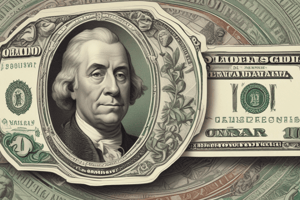Podcast
Questions and Answers
Quel est l'effet immédiat de l'inflation sur les individus?
Quel est l'effet immédiat de l'inflation sur les individus?
- Augmentation de la valeur de l'argent
- Stabilité des coûts de vie
- Diminution de la valeur de l'argent (correct)
- Réduction des dépenses publiques
Quel indice est utilisé pour mesurer l'inflation?
Quel indice est utilisé pour mesurer l'inflation?
- Indice des prix de détail
- Indice des prix de gros
- Indice des prix à la consommation (correct)
- Indice des prix à la production
Quel est le défaut de l'indice des prix à la consommation (CPI)?
Quel est le défaut de l'indice des prix à la consommation (CPI)?
- Ne prend pas en compte les effets de substitution
- Trop complexe à calculer
- Ne mesure que les biens et services de base
- Ne tient pas compte des changements de qualité (correct)
Quel est le but de la politique monétaire en ce qui concerne l'inflation?
Quel est le but de la politique monétaire en ce qui concerne l'inflation?
Quel est le type d'inflation causée par une augmentation de la demande?
Quel est le type d'inflation causée par une augmentation de la demande?
Quel est la cause de l'inflation due à une augmentation de la masse monétaire?
Quel est la cause de l'inflation due à une augmentation de la masse monétaire?
Quel est l'objectif principal de la politique monétaire en ce qui concerne l'inflation?
Quel est l'objectif principal de la politique monétaire en ce qui concerne l'inflation?
Quel type d'inflation est causé par une augmentation des coûts de production, tels que les salaires, les impôts et les matières premières?
Quel type d'inflation est causé par une augmentation des coûts de production, tels que les salaires, les impôts et les matières premières?
Quel est l'effet de la baisse des taux d'intérêt sur l'économie en période de faible inflation?
Quel est l'effet de la baisse des taux d'intérêt sur l'économie en période de faible inflation?
Quel est le facteur qui peut causer une inflation en augmentant la demande pour les biens et services?
Quel est le facteur qui peut causer une inflation en augmentant la demande pour les biens et services?
Quel outil les banques centrales utilisent-elles pour influencer l'inflation?
Quel outil les banques centrales utilisent-elles pour influencer l'inflation?
Quel est l'objectif de la mesure de l'inflation?
Quel est l'objectif de la mesure de l'inflation?
Flashcards are hidden until you start studying
Study Notes
Inflation: Effects, Measuring, Monetary Policy, Types, Causes
Inflation is a general increase in prices or the money supply, which can cause the purchasing power of a currency to decrease. It has significant effects on individuals, businesses, and the economy, and understanding its measurement, causes, and relationship with monetary policy is crucial.
Effects and Measuring Inflation
Inflation has several immediate effects on individuals, such as a decrease in the value of money and increased costs of living. For example, if the price of a specific product increases, people may need to spend more money to maintain the same standard of living.
To measure inflation, economists use various indices like the Consumer Price Index (CPI), which tracks changes in the prices of goods and services over time. The CPI measures the change in the value of a basket of goods and services. Economists also use the Gross Domestic Product (GDP) deflator, which measures the change in the value of all goods and services produced in an economy.
However, the CPI has some shortcomings. It does not account for changes in quality and may overstate the true inflation rate due to substitution effects. For example, if the price of a specific good increases, people may substitute it with a similar good. However, the CPI assumes that the basket of goods always remains the same, which can overstate the true inflation rate.
Monetary Policy and Inflation
Monetary policy is the use of tools by central banks, such as the Federal Reserve, to influence the economy. One of the primary goals of monetary policy is to control inflation. Central banks often use interest rates to influence inflation. When inflation is high, the central bank may increase interest rates to reduce borrowing and spending, thus slowing the economy and reducing inflation. Conversely, when inflation is low, the central bank may lower interest rates to stimulate borrowing and spending, which can help boost the economy.
Types of Inflation
There are several types of inflation, including:
- Demand-pull inflation: Occurs when demand for goods and services exceeds the supply, causing prices to rise.
- Cost-push inflation: Resulting from increased production costs, such as wages, taxes, and raw materials.
- Structural inflation: Occurs when changes in the economy lead to a persistent inflation rate, such as changes in government policy or labor market conditions.
- Hyperinflation: A rapid and out-of-control increase in prices, often associated with economic instability.
Causes of Inflation
Inflation can be caused by various factors, including:
- Demand-side factors: Excessive demand for goods and services, leading to price increases.
- Supply-side factors: Increased production costs, such as wages, taxes, and raw materials, causing prices to rise.
- Government policies: Fiscal policies, such as increased government spending or tax cuts, can lead to inflation if they increase demand without a corresponding increase in supply.
- External factors: Changes in global oil prices, commodity prices, or exchange rates can affect the cost of goods and services.
Conclusion
Inflation is a complex economic phenomenon that can have significant effects on individuals, businesses, and the economy. Understanding its measurement, causes, and relationship with monetary policy is essential to ensure economic stability. Central banks use various tools, such as interest rates, to control inflation and maintain a stable economy. By monitoring inflation, economists can make informed decisions about the economy and the effects of various policies on the cost of living.
Studying That Suits You
Use AI to generate personalized quizzes and flashcards to suit your learning preferences.




